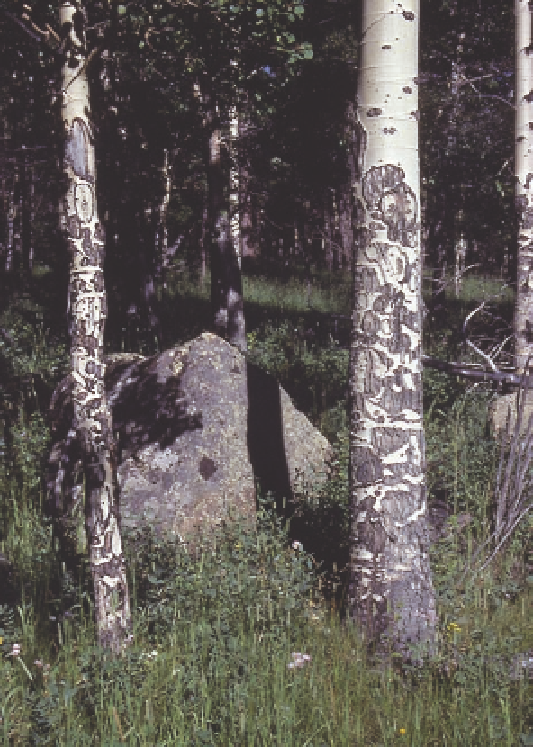Geoscience Reference
In-Depth Information
every spring and fall between summer and winter
ranges. the summer ranges usually are at higher eleva-
tions, where plant productivity and forage availability
are greater because of the cooler, wetter environment.
Winter ranges are in the low-elevation foothills and
valleys (see chapter 10), where snow accumulation is
less and animals can forage until spring. However, the
relatively low productivity of winter range vegetation,
coupled with concentrations of animals for periods of
several months, leads to heavy use of forage plants—
including shrubs and trees. Browse lines developed on
junipers, willows, and other tall shrubs (see fig. 10.16),
mature aspen were scarred after elk ate some of the bark,
and most aspen sprouts were snipped off before they
could grow into new trees (see figs. 10.14 and 10.15).
Recognizing that conversion of land to agriculture
and towns was reducing the availability of critical win-
ter range for elk and deer throughout much of the West,
federal and state agencies initiated winter feeding pro-
grams to help maintain ungulate populations. in 1912
the national elk Refuge in Jackson Hole was established
on the fertile bottomlands along Flat creek. Wintering
elk began to congregate there by the thousands every
Fish Department developed similar feeding programs
elsewhere. From the beginning, there has been contro-
versy over the wisdom of this practice. the benefits are
perceived to be fewer agricultural conflicts, larger herds
for hunters, and less discomfort about animals starving
during harsh winters. However, the problems include
cost, injury of trees and other forage plants in the vicin-
ity of feeding grounds, disease transmission to livestock
(such as brucellosis), and fostering the public perception
that suitable habitat is not important.
48
Arrival of the Leopold report in the 1960s led to
a fundamental rethinking of YnP's management
approach. Some scientists argued that YnP's winter
range was not overgrazed, pointing out that native
rangelands remained basically intact and continued
to sustain impressively large numbers of elk and other
wildlife.
Beginning in 1968, YnP terminated culling
elk herds in the park, and—as an experiment—began
observing whether the Yellowstone elk population was
capable of self-regulation. the park also implemented a
research program to better understand the dynamics of
elk and their habitat.
Fig. 15.12. the scars on these aspen were caused by elk feed-
ing on the bark, a common occurrence on trees near winter
ranges.
With the loss of tall willows came problems for
associated wildlife, including loss of nesting habitat
elk for food was thought to be affecting populations
of deer and beaver. Some critics argued that few or no
elk had occupied the winter range inside YnP until the
late-1800s, when land use changes north of the park
boundary restricted the animals to the park. to test this
hypothesis, historians Paul Schullery and Lee Whittle-
sey reviewed all observations made by explorers before
1882. they concluded that the record is not sufficiently
detailed to know in any given year whether the elk
population equaled, exceeded, or was less than at pres-
ent, but they became convinced that the park area was a
winter range for thousands of elk before 1882.
46
these concerns were not unique to YnP. in the GYe
and throughout much of the West, elk and deer migrate

Search WWH ::

Custom Search